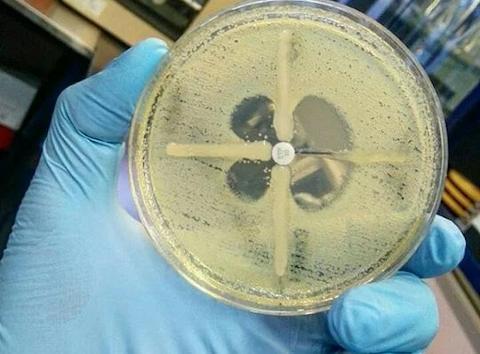Modified Hodge Test: Procedure and Interpretation
The modified Hodge test is a simple and effective method for detecting carbapenemase-producing Enterobacteriaceae (CPE). It is routinely used to identify strains with reduced susceptibility (intermediate or resistant) to carbapenems.
Indications for the Test
- Objective: Detect carbapenemase production in Enterobacteriaceae.
- Target strains: Any strain showing reduced susceptibility (I/R) to at least one carbapenem should be considered a suspected CPE.
Procedure
Required Materials
- Control strain: Escherichia coli ATCC 25922.
- Antibiotic discs: Meropenem (10 µg) or ertapenem (10 µg).
- Mueller Hinton agar.
- Sterile broth or saline solution.
Steps
- Prepare a suspension of E. coli ATCC 25922 at a density of 0.5 McFarland in 5 ml of broth or saline solution.
- Dilute the suspension 1:10.
- Inoculate the dilution onto a Mueller Hinton agar plate, as for a standard antibiogram.
- Place a meropenem (10 µg) or ertapenem (10 µg) disc at the center of the Petri dish.
- Inoculate the test strain in a straight line from the edge of the disc to the edge of the plate.
- Repeat with a positive control strain (carbapenemase-producing) and a negative control strain (non-producing).
- Incubate the plate at 35 ± 2 °C in ambient air for 16 to 24 hours.
Interpretation
Positive Test
- Observation: A deformation or cleavage of the inhibition zone around the carbapenem disc, forming a "cloverleaf" shape.
- Significance: The test strain produces carbapenemases, which hydrolyze the carbapenem and allow E. coli ATCC 25922 to grow within the inhibition zone.
Negative Test
- Observation: No deformation of the inhibition zone. The growth of E. coli ATCC 25922 is uniformly inhibited around the disc.
- Significance: The test strain does not produce carbapenemases.

Limitations of the Test
- The modified Hodge test may yield false negatives with certain carbapenemases (e.g., OXA-48).
- It cannot differentiate between types of carbapenemases.
- Strains producing extended-spectrum beta-lactamases (ESBLs) or cephalosporinases may sometimes yield false-positive results.